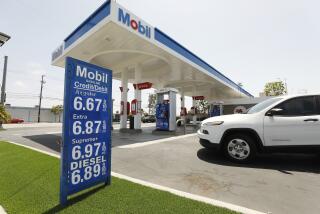Gas Prices: No Cheap Fix
- Share via
Energy Secretary Bill Richardson has been making the rounds of the world’s major oil producers, lobbying with mixed success for increases in output that would lead to lower gasoline and heating oil prices in the United States and elsewhere. Saudi Arabia, the world’s biggest producer, seems inclined to cooperate and is already quietly putting more oil on the market. But Venezuela, another top supplier to the United States, says it’s not ready yet to start pumping more, and that news has kicked up future oil prices another notch.
Retail gasoline prices in the United States are now at a 19-year high. Pump prices in Greater Los Angeles average above $1.40 a gallon. In San Francisco, it’s $1.60. There’s no relief in sight.
The American Petroleum Institute, a trade group, says gasoline inventories fell 432,000 barrels--a barrel equals 42 gallons--in mid-February. That left inventories 15% lower than a year ago. Refiners will have to buy crude oil, at high prices, to replenish their stocks. And the cost of crude oil, if the 11-member OPEC and other big producers have their way, seems likely to stay relatively high.
Fourteen months ago, the OPEC producers and nonmembers Norway and Mexico agreed to cut their production by 4.3 million barrels a day to stimulate prices, which had sagged to about $11 a barrel. It worked. Recovering Asian economies boosted energy demand. So did profligate consumption habits in the United States, the world’s No. 1 oil consumer. In February, for example, U.S. gasoline demand stood at 8.3 million barrels a day, 4.5% higher than a year earlier.
Saudi Arabia, Mexico and other producers understand that their economies would suffer if excessive oil prices pushed the United States into recession, as happened in the 1970s. They think oil could sell in the range of $25 to $30 a barrel without undermining the global economy. The sooner supplies expand, the sooner prices will stabilize.
But even if the producers raise output, continuing high demand and the need to rebuild inventories seem sure to keep prices well above what Americans have become used to paying in recent years. Blame our own motoring appetites as well. All those gas guzzlers on the road, all those extra travel miles, come at a price. We’re paying it now, and from the looks of things we’ll be paying it for some time to come.
More to Read
Inside the business of entertainment
The Wide Shot brings you news, analysis and insights on everything from streaming wars to production — and what it all means for the future.
You may occasionally receive promotional content from the Los Angeles Times.










